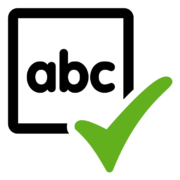Copywriting typos and why we don’t see them
 Even the most vigilant copywriting means making typos. And sometimes, those typos get published. Some are hilarious, some are just downright embarrassing. But all are due to the fact that we see what we expect to see.
Even the most vigilant copywriting means making typos. And sometimes, those typos get published. Some are hilarious, some are just downright embarrassing. But all are due to the fact that we see what we expect to see.
Seeing copywriting that isn’t there
The reason we miss typos is that we look for what writing is — and not what writing isn’t. What writing is, in most cases, is a format that we use to communicate meaning. In fact, when you think about it, the written word (aka, copywriting), is actually an interface. So no wonder that articles about good user experience talk about copywriting. Copywriting is what we’ve got to communicate with.
While it’s fascinating to see what the brain misses, there’s a more interesting illusion that lets us see how much it catches. Take a paragraph and jumble up all the letters, except the first and last of each word. Amazingly, it’s fairly easy to read the paragraph and understand what it says.
Why does this work? Turns out, it’s about patterns. Researchers found that you could make the whole word jumble incomprehensible simply by moving letters too far from their rightful positions in a properly spelled word.
What’s more, English is especially easy to do this with due to the length of typical words. As long as you keep letters near where they should be, you can mix them up and they’re still understandable. German works well for this, too. Hebrew, however, becomes unreadable because it has no written vowels so you’re already filling in the blanks.
Seeing the copywriting that is there
Whether or not the writing’s on the wall, or on the desktop, mobile phone or kiosk, it’s the interface we have to work with in today’s world. And while typos matter, what matters most is making sure your company’s story inspires your customers to take action.
If you need a copywriter who can do that, I’m hear* for you.
* Typo intentional.
About the author: Karen Goldfarb

Award-winning freelance copywriter and marketing strategist who writes everything from websites to videos, TV ads to Facebook games. I understand your audience, ensure your copy is compelling, and help you make the right offer at the right time. Clients have included Apple, Revlon, Lipton Tea, Microsoft, Red Lobster and Hello Kitty/Sanrio.
Join me on karen-goldfarb.com




Hi Karen,
Thanks for the article. I have one question and one (debatable) issue. Here goes…
The question comes from the first paragraph’s statement about what copywriting is and isn’t. While you explain what it is, there’s no explanation of what it’s not. Can you explain that statement ‘set-up’ in terms of 1. why the ‘isn’t’ wasn’t explained and 2. what were you trying to communicate with that sentence? It looked as if you were trying to set up a dichotomy to make a point. Perhaps I missed it.
My ‘issue’ concerns your statement that Hebrew “becomes unreadable because it has no written vowels.” If you’re talking about the written words in the Torah, you’re correct. You’re also living in the past. I believe it’s Armaic, though I’m not sure, but in Hebrew school, we were taught Hebrew, and the vowels were there. Underneath the letters, but there nonetheless.
Hi Richard,
Thanks for your feedback.
As far as what writing isn’t, it isn’t like code to a computer, where one small error will throw off an application from operating properly. Our brain is more flexible about context which is why you can jumble up letters and as long as you keep them close enough to each other, we can still read the words. In fact, our brains don’t read one letter at a time, but read the word as a whole.
My comment about Hebrew referred to the original article I linked to which mentions the colleague that tried this experiment with Hebrew, but it doesn’t mention which version or dialect that person used. I don’t speak or write Hebrew myself. Perhaps you should try the experiment with the version of Hebrew you learned and see if it works or not. If you do, please let me know what you find out.